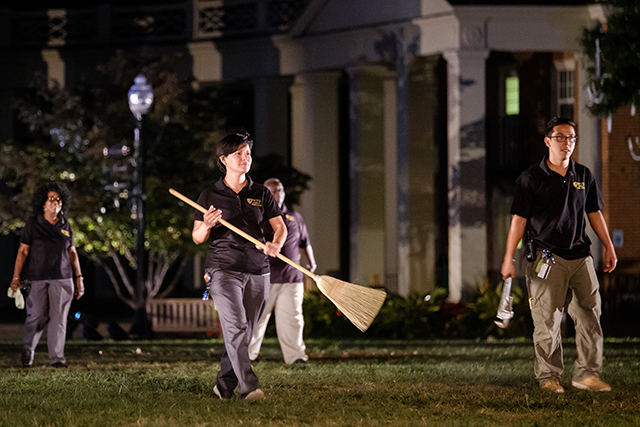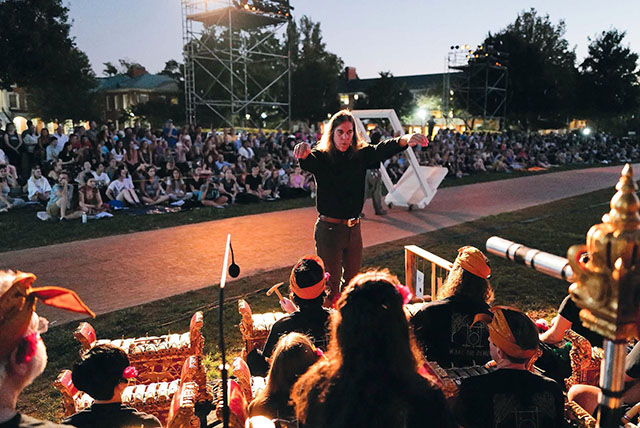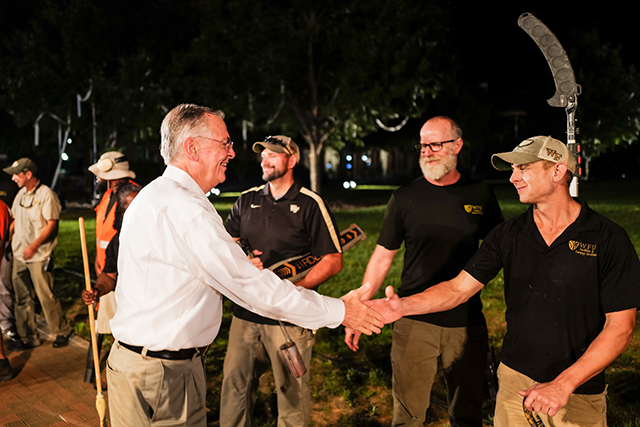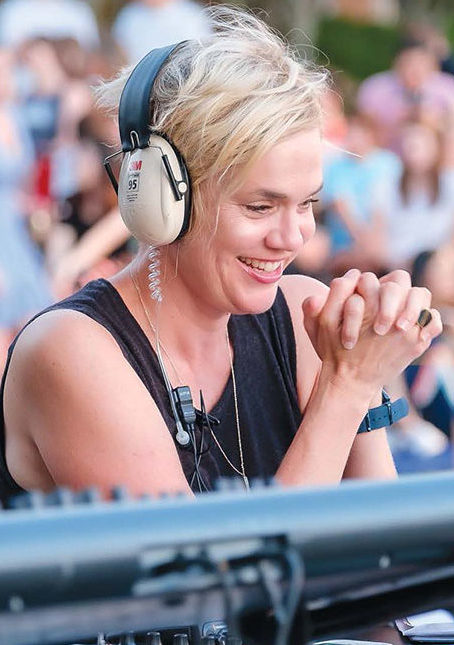
Allison Orr (’93) presents herself to a room full of skeptics and scans the lunch tables for a receptive smile. She has come to woo them.
These 200-plus people keep Wake Forest repaired, running and beautiful. They have cleaned their plates, and they still have dorms to vacuum and lawns to mow before the day is done. Some stare off to the side at this luncheon in Benson University Center. Others rest an elbow on the table and put cheek in palm in the universal sign of meeting weariness.
This is not even close to the toughest crowd Allison has ever courted. This is normal, she says.
Allison is an award-winning choreographer who designs extraordinary outdoor performances based on ordinary jobs. She has set her heart on turning the heads of the University’s facilities staff.
She and her team from Forklift Danceworks in Austin, Texas, have secured grants from the New England Foundation for the Arts and the National Endowment for the Arts to “tour her process” for her shows, which have won acclaim for nearly 20 years. The grants will fund shows and artistic residencies on three college campuses. The first was Williams College in Massachusetts, where the dining staff showed the logistical beauty of feeding the masses. The second is Allison’s alma mater.
This isn’t dance like “Dancing with the Stars” or “Stomp” on a Broadway stage. It isn’t like anything other artists do. Allison creates spectacular ballets of trash collectors or electrical line workers in dinosaur-sized bucket trucks reaching to the sky in unison. All of it is set to original live music, with theatrical nighttime lighting and recordings of workers’ voices piped over loudspeakers telling the story of what they do and why it matters.
“Think of it as movement,” she tells the employees in Facilities & Campus Services. “You’re just doing what you already know how to do.”
Custodians, carpenters, electricians and landscapers are not accustomed to this kind of attention. They aren’t open yet to her advances.
But “the chief troublemaker,” as Allison calls herself, has the relentless confidence of Casanova. She knows her dance with these performers-to-be will take its own sweet time.
But first things first.
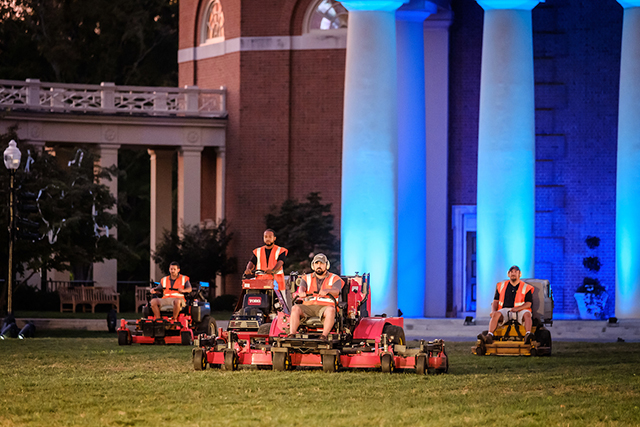
Landscapers rev their engines.
Setting the Stage
Allison always danced and has an MFA in choreography from Mills College in Oakland, California. She danced and choreographed as an undergrad with Wake Forest Dance Company, while she majored in anthropology and minored in women’s studies. Culture fascinated her. She says she never rolled the Quad or did “the school spirit thing.” She was staying up late figuring out how to fight racism and homelessness, rallying for women’s issues and carrying a pager for a domestic violence hotline. She was as oblivious as most students to the workers who kept her school clean and comfortable. But even then, she understood the power of community and the importance of fairness.
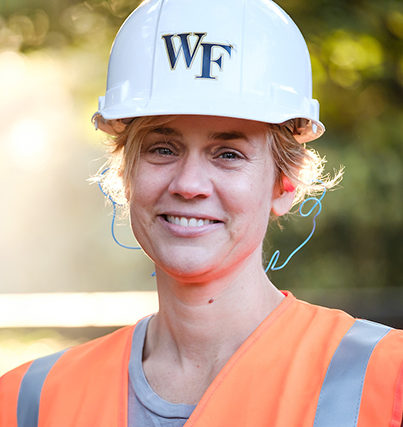 She says Professor of Music Peter Kairoff inspired the direction of her arts career. “It’s his fault. He started this,” she says. After graduation, she worked in 1995 as his student assistant and nanny for his family in Venice, Italy, while he taught at Casa Artom for a semester.
She says Professor of Music Peter Kairoff inspired the direction of her arts career. “It’s his fault. He started this,” she says. After graduation, she worked in 1995 as his student assistant and nanny for his family in Venice, Italy, while he taught at Casa Artom for a semester.
She eventually returned home for a job as a social worker, then went to graduate school in dance before ending up in Venice again in 2001. Kairoff happened to be there for the summer. The beauty and strength of the gondoliers who traveled the Venetian canals entranced Allison. She wanted to choreograph them, but this elite all-male group fended off all outsiders, especially a young American woman.
Kairoff encouraged her to persist, even though gondoliers, he says, “won’t talk to you, won’t work with you.” She spoke Italian. She took rowing lessons. She befriended one gondolier, then another. She beguiled eight of them. Together, they produced a show in 2003 and an encore in 2004.
“Allison got in there, and they’re still talking about it in Venice,” Kairoff says.
No group since the gondoliers has proven more difficult to win over, she says. Not the firefighters, the trash collectors or the electrical line workers. Not the professional female baseball team in Japan or the Elvis impersonators. Not the swimmers and workers at the disintegrating community pools in Austin. The mayor of Austin called the three-year pools project “an extraordinary opportunity for residents, artists and civic and community leaders to work together to explore and address equity and access issues.” A city budget official happened to attend a show, Allison says. The result was a small fee hike that will produce more than $1 million to repair and save the pools.
A documentary called “Trash Dance” about Allison’s show with Austin sanitation workers won awards at the SXSW film festival, the Full Frame Documentary Festival and more. It led The New York Times to call Allison in an admiring review “a skinny live wire who finds rhythm in routines and elegance in the everyday.”
She is writing a book about her process, which follows a similar arc each time. First, she sets the foundation with institutional leaders.
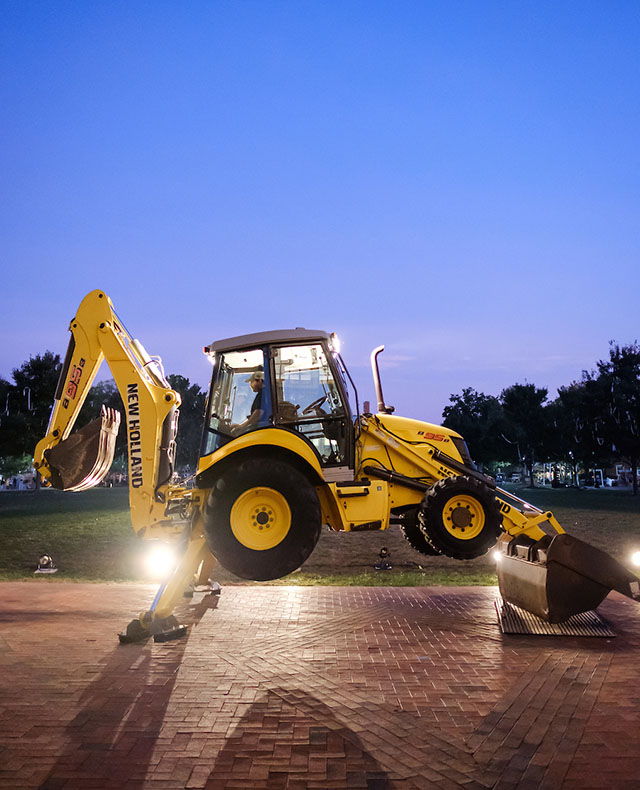
At Wake Forest, Associate Provost for the Arts Christina Soriano finds out about Allison’s NEA grant and asks her to create a performance at Wake Forest. Soriano already knows Allison because Kairoff had suggested they connect. Soriano teaches and studies dance and its impact on people with Parkinson’s disease, so she fell immediately for Allison and her community focus.
By 2017, Allison, Soriano and Theatre Professor Cynthia Gendrich meet in a tiny office in Scales Fine Arts Center to begin cooking up the show, which workers will dub “From the Ground Up.” Gendrich secures an additional grant from the New England Foundation for the Arts for the October 2019 show.
Soriano and Gendrich see the performing arts and campus workers as a perfect marriage for a university intent on celebrating and expanding its arts community and supporting inclusiveness.
“What I know is that the performing arts are especially good at encouraging empathy, and when you watch or listen to people doing virtuosic things, your respect for them expands,” Gendrich says. She is founding director of IPLACe, the Interdisciplinary Performance and the Liberal Arts Center, which supports and organizes arts events on campus and sponsors Allison’s show.
Signing up John Shenette, vice president of Facilities & Campus Services, to back the show is easy. He and Stephanie Poskin, director of facilities support services & operations, take on the jigsaw puzzle of logistics and cost as they would for any major campus event — while also scheduling their workers to participate.
“When you talk about challenges within higher ed, this is an opportunity to showcase the importance of the human capital,” Shenette says. “My only request is that we do it better than anybody else has done. We want to set the bar.”
Shenette says most outdoor performances take place on Manchester Plaza. But Allison wants the Quad, and resisting Allison is futile. “We tell most groups ‘no,’” Shenette says, “but this is the iconic place. It’s an indication of how important this is.”

Custodian Judy Dunovant, practicing moves in front of Wait Chapel as the lead figure in the finale, let her personality emerge as she grew more comfortable with the routines.
Opening Hearts and Minds
With support from the top, Allison begins her charm offensive from what indeed is the ground up.
She makes six visits to campus, away from her husband, 12-year-old daughter and 8-year-old son, to conduct six artistic residencies with students and faculty. On each visit, she packs her schedule to meet custodial, maintenance & utilities, landscaping, construction and waste reduction workers.
She tags along with dozens of workers. Shadowing isn’t the right word, because she doesn’t stay in the background. She hauls trash. She cleans bathrooms. She hammers. She straps on the 12-pound portable vacuum pack. She needs to feel the movements to choreograph scenes faithful to the nature of the work, and she wants to know her campus partners and build their trust.
Allison wants to do everything the workers do. If she could, she would rappel out of a tree like arboriculture workers will do in the show. “I wanted to rappel down the chapel,” she says, but not even she can sweet-talk OSHA.
She especially loves trucks and big machines. Her head swivels and her voice jumps an octave every time she spots an oversized vehicle. “Oh, that’s a street sweeper. Is that yours? Awesome!”
When the construction team tests out its biggest rigs on the Quad, Allison woo-hoos as a forklift reaches high against the backdrop of Wait Chapel’s spire.
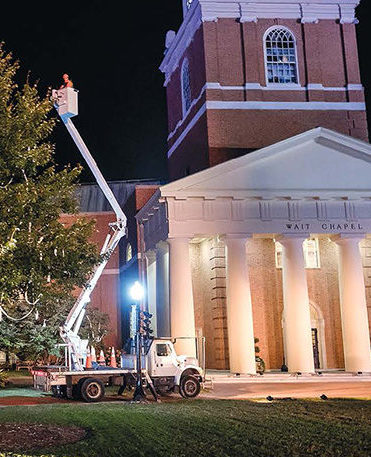
“Cool! I wanted more shock and awe!”
“You’re going to make something this community has never seen before.”
Allison admits to facilities workers that she basically “tricks them” into signing up for this project — not with deception, but by enticing them into helping in small ways that lead to big ways.
“Just come to a meeting to throw around ideas. You’re not signing up. We have some ideas. Some bad ideas. We want your good ideas,” she says. “You’re going to make something this community has never seen before.”
Eventually, she asks staffers to help block out some storyboarded moves, no commitment. She wins over informal leaders in every group to share the love. She repeats many times that they will be paid. They’ll rehearse during regular hours or receive overtime. She dangles the time-honored hook — free food.
Allison makes a special effort to visit Spanish-speaking custodial employees (she’s fluent, thanks to four summers in Latin America). She meets Doris Lopez, a quiet custodian who grew up in Ecuador and began working at Wake Forest a few months earlier. When Allison hints about the show, Lopez demurs. She says she’s too new to Wake Forest.
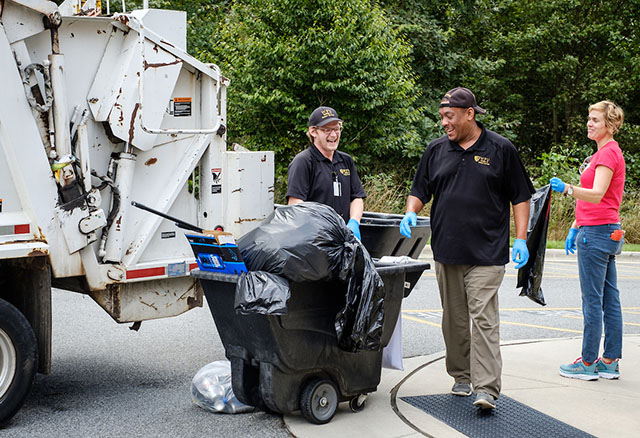
Allison carries out trash from a dorm with custodian London Thomas (left) and sanitation employee Roger Roberts.
Falling in Love
Allison is wooing employees, but she’s the one falling in love.
She bonds with landscaping team leader Chris Boston. “He has the biggest heart,” she says.
His team mows, weeds and edges. Boston says they avoid mowing too early or making noise during exam times so students can sleep and study. “You have to respect the babies.”

Landscaper Chris Boston on Manchester Plaza
He loves the outdoors, and like Allison, he loves equipment — mowers, spreaders, even street sweepers. Grass-seeding is six weeks away, and “I cannot wait. I jump on the plugger; I won’t get off of it.”
In her standard jeans, T-shirt, sneakers and a Deacon ball cap, Allison learns from the custodial staff the secrets to good vacuuming as well as the down-and-dirty secrets of dorm life. She sees how much they care about the students. Judy Dunovant, a 24-year veteran, says one student last year never acknowledged her when she cleaned his bathroom. “At the end of the year he came up with some flowers and some candy, and I said, ‘What’s this for?’ He said, ‘You used to brighten my day.’ He was a sweetheart.”
Allison plumbs the workers’ stories, as do her high-energy associate artistic director, Krissie Marty, and her assistant choreographer, Gretchen LaMotte. They observe the maintenance team responding with 911 efficiency to streams of calls about broken lights and leaky toilets.
The third-shift team educates Allison about how they unload their equipment, carry out a lobby’s worth of furniture, clean and wax the floors and return it all to normal before disappearing like elves in the night. The rapid-response team laughs about the plagues of the wee hours — blood, dog feces, human feces, vomit, broken glass.
Allison studies the intricate work by the locksmith team of Sloan Cole, David Moore, Kobak Taylor and manager Mark Mayberry. At least one is on call, 24/7, 365, to help locked-out students or ensure campus security by quickly replacing damaged doors or locks. They are a sardonic bunch, but they take to Allison on the first date and start planning their own scene. Allison is stoked.
She is drawn to one of the most respected and admired men in maintenance, master carpenter Hugh Brown (P ’09), a quiet man who will retire in March after 37 years, which means he was on campus in Allison’s undergrad time. She learns that one of his daughters outed his singing ability by sending facilities a video of him rocking “Blue Christmas” in an Elvis costume for his church holiday program. This makes him a marked man for Allison.
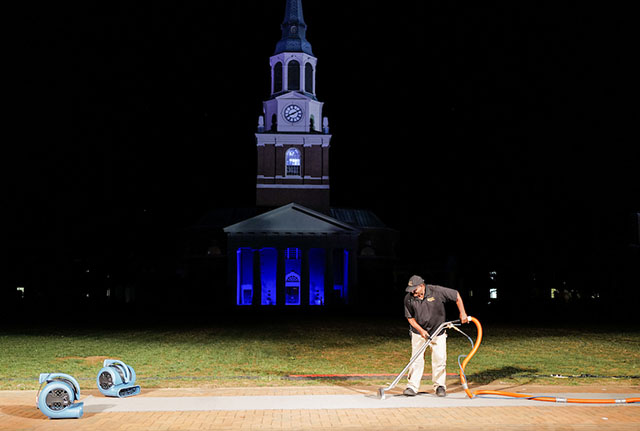
Ron Mitchell, above, demonstrates his floor-cleaning skills in the night crew’s scene. In the voice-over, William Washington tells of a student’s accidental dorm fire. “Common sense should tell you that plastic doesn’t belong in an oven. Maybe he was just hungry and not thinking,” Washington says with a chuckle.
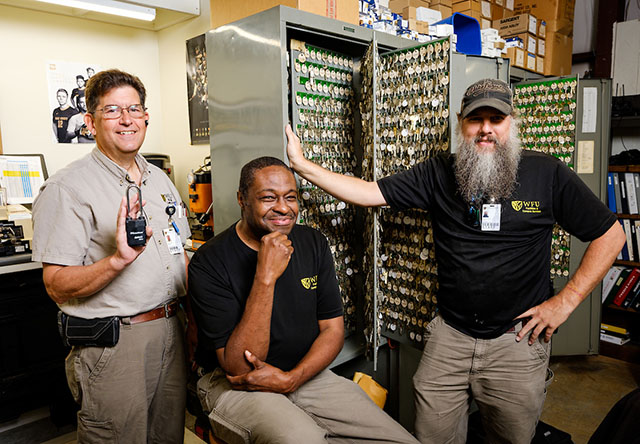
From left. the locksmith team of David Moore, Kobak Taylor and Sloan Cole in their workspace chock full of keys and parts.
Allison studies the intricate work by the locksmith team of Sloan Cole, David Moore, Kobak Taylor (seen above) and manager Mark Mayberry. At least one is on call, 24/7, 365, to help locked-out students or ensure campus security by quickly replacing damaged doors or locks. They are a sardonic bunch, but they take to Allison on the first date and start planning their own scene. Allison is stoked.
She is drawn to one of the most respected and admired men in maintenance, master carpenter Hugh Brown (P ’09), a quiet man who will retire in March after 37 years, which means he was on campus in Allison’s undergrad time. She learns that one of his daughters outed his singing ability by sending facilities a video of him rocking “Blue Christmas” in an Elvis costume for his church holiday program. This makes him a marked man for Allison.
Who is Allison Orr?
Like so many Wake Foresters, Allison has pulled threads from disparate interests in her liberal arts education and woven them into a perfect combination of her interests and values.
At the core is work. Her own is vigorous. On campus, she often starts before sunrise and continues through the night. Back in Austin, she sketches performance ideas and juggles multiple projects. Moving and dancing have always burned off her copious energy, she says.
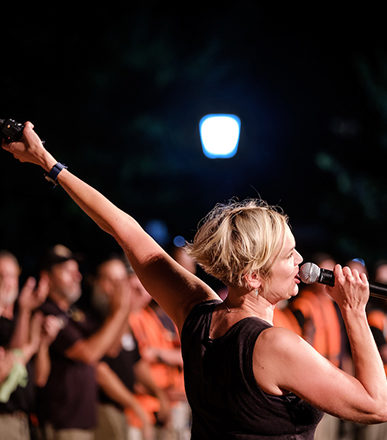 Work defined Allison’s family of fifth-generation Texan Protestants. “I come from a long line of people who hold work in high esteem and appreciate a job well done,” she says.
Work defined Allison’s family of fifth-generation Texan Protestants. “I come from a long line of people who hold work in high esteem and appreciate a job well done,” she says.
Her father, an attorney, reached affluence by the time she was in high school, but her grandparents were farmers. “I like to say that we might not have greeted each other warmly or lingered over meals, but what we like to do is work together. That’s how we connect. You don’t stand around too long without my mom asking you to do something.”
Her grandfather, a big figure in her life, “was the epitome of a tall, big-talking Texan,” and she absorbed his art of conversation. “My grandfather could talk to a park bench.”
Her parents imbued a devotion to community-building. Her father, a civil rights activist, helped her with an eighth-grade project on why her neighbors sent their children to private schools. “It was definitely modeling of ‘How are you a citizen in the world? How are you in service and — it sounds hokey — giving back?’”
A worker washing windows in the cafeteria inspired her first dance piece in graduate school. “I thought, ‘Oh, my gosh, that’s the most interesting choreography I’ve seen all year.’”
She sees movement as a common bond among humans, and she believes everyone is inherently creative. Her work aims to create opportunities for relationships, for empathy, for acknowledging each person’s value, for altering perspectives and enriching lives.
“I’m convinced that every problem in the world could be solved if we just understood each other.”

Show Day Arrives
No idea is too big for Allison, and some days are discouraging as she pushes against the protective walls around working-class groups. But she camouflages doubts with smiling energy.
In September, Marty distributes layout maps of the Quad to custodial employees blocking out moves at Wait Chapel. Dunovant, a lead player, studies it and remarks, “Wow, you guys have done a lot of work.”

Hugh Brown (P ’09), a master carpenter with 37 years on campus, speaks softly but regularly slips in jokes on his colleagues.
Allison responds: “Yes, we do work hard. Thank you for noticing.”
That’s the same answer workers give Allison when she asks what they want the campus to know about them.
Good humor and hugs increase with each rehearsal. During a brainstorming session, mild-mannered Brown offers up a few sly jokes: “For music we could use ‘Take This Job and Shove it.’”
Allison talks on her cellphone one evening with her husband, Blake Trabulsi. He asks if it’s turning out as she expected. “Yes, it is,” she tells him. “I knew what I wanted it to look like from the first time I stood on the Quad. I’m so proud of them.”
In the week before showtime, performers work until 9 p.m. to rehearse with the band under nighttime lighting. Many are exhausted, including Allison, who is red-faced in the heat wave that still bakes the Quad. But spirits soar.
“Hello, fellow rock stars,” says Shenette. “Are we nervous?”
“Nah, we got this,” custodian Cynthia Wilson responds.
By the first 7 p.m. show on Oct. 3, the sky turns pink with a romantic crescent moon over the Quad arch. Purple theater lights bathe Wait Chapel’s columns. Allison has lured 70 workers to perform 15 scenes, and virtually every facilities employee is helping in some way. Students, faculty, staff, their families and the public amble to the bleachers and lawn space for 1,000 spectators. As the crowd grows each night for the three performances, workers move the bleachers farther back to open more lawn seating along the Quad’s middle sidewalk, a main stage.
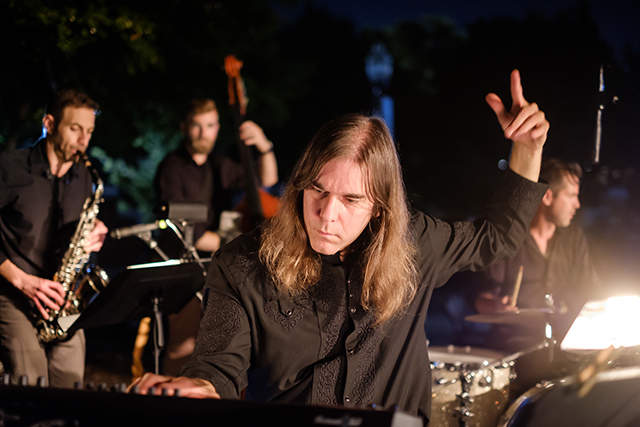
Music is provided by an eight-piece band composed of musicians from Winston-Salem and Austin, Texas. The group is led by Composer Graham Reynolds of Austin (above, center) and features, among others, saxophonist Ali Sakkal (left), associate teaching professor in the Department of Education.
After a rousing first blast by the eight-piece band of Austin, Wake Forest and Winston-Salem musicians, the carillon tolls a solemn welcome. Matthew Bennett walks the ground to locate underground wires. Tommy Crews and Ron Whitlock explain the ubiquitous cables and pipes running underneath campus. “Everybody’s walking on something. You’re walking on power,” the voice-over booms from loudspeakers on the Quad. The metaphor is apt; facilities staff are as critical, and often as invisible, as this grid.
The band kicks into high-energy riffs. Ali Sakkal, an associate teaching professor in education, wails on his saxophone. Boston and the turf crew on mowers speed onto the lawn. They spin, whirl, crisscross in near-misses and even pop a wheelie. The crowd cheers. Youngsters go wide-eyed and wiggly with excitement. The big forklifts and backhoes, still to come, are a 4-year-old’s dream.
Custodian Doris Lopez — yes, she finally fell under Allison’s spell — and five colleagues roll out their yellow-and-red cleaning carts, wheeling around in unison, spinning their mops and juggling toilet paper rolls as they groove to the beat.
Allison captures hearts (and airs the groundskeepers’ top gripe) with the voice-over by Jim Mussetter, the University arborist. As with all the voice-overs, Allison uses unscripted recordings of her conversations with workers.

Arborist team leader Jim Mussetter cuts an imposing figure with his chainsaw, but he has a soft heart for trees. His team plants a new tree on average every two days.
Mussetter (pictured right), a sturdy 6-foot-2 oak of a man, declares his love of trees. “We do everything we can do to protect them and nurture them. Some of them I consider like my children.”
He wishes victories could be celebrated with a different tradition than rolling the Quad and its trees with toilet paper. The grounds team spends two hours picking up shreds after each Deacon sports win, then a half-hour to an hour a day as the bits litter the Quad for weeks.
“I heard it described once that we’re covering the trees with the dead skin of their brothers and sisters. That’s the perfect way to put it. … It’s taking away from our main purpose of caring for the trees,” Mussetter says as orange-vested workers gather the paper pieces.
Allison hits a creative jackpot with the University’s gamelan, a Balinese instrument of gongs and cymbals. The locksmiths roll out two door frames, hang two doors and install locks in them to the perfect tick-tock of the gamelan’s percussive metallic tinkling.
In “Solo Sorter,” Ernie Johnson, a one-man recycling operation who never misses a chance to make a friend, tugs at hearts again with his voice-over. “Every bag is an experience,” he says to laughter from those who have seen the Monday morning fallout from a party weekend. As he sorts each bag, one banana peel or slice of pizza can condemn the whole bag to the landfill.
“The frustrating thing is to open up bag after bag and see that it’s contaminated,” Johnson says. “I’m passionate about my job and getting it done, and getting it done right. Everything I do, I do from the bottom of my heart, and I do it with strength. I do it with love, and I do it with conviction. And that’s me.”
Allison sits with the band, directing through her radio headset to her team and the student stage managers who cue performers. She grins and shimmies with the music. The light show, directed by award-winning designer Stephen Pruitt, grows tighter each night. Allison and composer Graham Reynolds work symbiotically. Allison taps him at scene changes, and Reynolds, who plays wicked keyboards, flashes hand signals to the band for volume or points of emphasis. He wrote the original score, with styles that range from what he calls “retro film jazz with a dirty, slow beat” to earworm-inducing saxophone and violin riffs.

A string of white maintenance vans lines up at the chapel, headlights beaming and hazard lights blinking at the crowd. Two flatbed trucks, fitted with mini versions of a dorm room and an office, roll to the middle sidewalk. As radio dispatchers call for service, the vans streak to the flatbeds in a growing frenzy of workers changing lights, fixing an overflowing toilet, replacing a broken mirror. “Over in Reynolda Hall there’s an office that is too hot,” the dispatcher’s radio crackles. The audience giggles, knowing that’s where the University’s top administrators take the heat.
In a quiet scene called “The Center of the World,” poignant violins play as foreman Benny O’Neal and carpenters Kevin Badgett and Ben Venable show how workers identify the center point of Hearn Plaza.
“We set up 13,000 chairs on the Quad for Commencement. It takes us 2 ½ days,” says the voice-over from general superintendent J.L. Bolt (P ’10). “All the work we do at facilities is to get the student to graduate and walk across this field. We help prepare them to go off into the world.”
As the violins transition into fiddle music, the scene that follows is the closest thing to a traditional arts performance — the gospel song “I’ll Fly Away,” performed by Brown, the singing carpenter, in the lead with custodians Teresa Bowles, Sharon Taylor, Brenda Wall and Michael Woodard. Allison wanted a religious song with an Appalachian feel. The choice evokes images of students taking wing, as well as Brown’s impending departure from Wake Forest.
The carillon and swirling neon lights cue the finale. The front door of Wait Chapel swings open, and a solitary backlit figure emerges. It’s Dunovant.
“We are facilities,” her voice-over pronounces. “We are definitely the backbone of the University.”
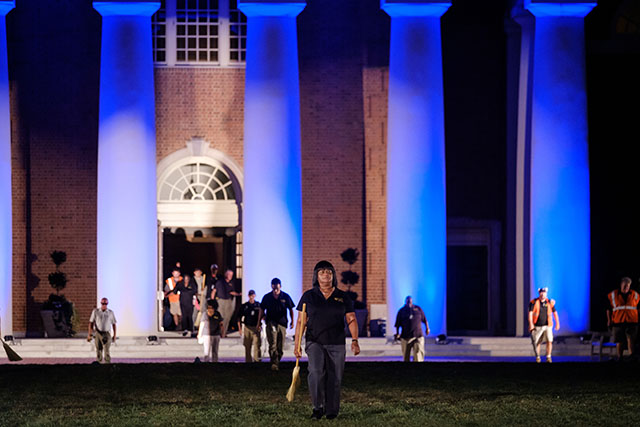
Custodian Judy Dunovant stars in the show's finale. “We are facilities,” her voice-over pronounces. “We are definitely the backbone of the University.”
Dunovant, broom in hand, walks to the music’s beat, moving down the Quad. In twos and fours and eights, ever-larger groups flow out of the chapel doors, each person holding a tool of the job. They form an army, yet no one blocks another from the audience’s view, as Allison directed. Eventually, all stand aligned before the audience, in one row.
To a standing ovation, they hold hands as Allison leads them in three Broadway bows.
Afterward, in a buzz of warm feelings, landscaper Boston praises Allison and her team. “We were hot and aggravated, and she put up with our mixed feelings and mixed signals. They were patient with us.”
Many echoed Boston’s bottom line: “It really means a lot to be appreciated.”
At the cast party Saturday night at Campus Gas, carpenter Kevin “Squirrel” Badgett can’t stop grinning. “I was so excited I couldn’t sleep. I couldn’t wait ’til tonight to do it again. I want to do it again Monday.”
Allison reminds the group that they drew her to campus for the first time since she graduated in 1993. “You have made Wake Forest a different place for me, and I’m forever grateful. What you’re doing is a gift. We’re changing the world. It may not feel like it, but something you do will strike people, and they will change how they see things.”
Leaving behind new relationships to go home isn’t easy, Allison says, but she’ll stay in touch and won’t forget any of her loves. After all this time, she’s still friends with the gondoliers.
Each project amazes her as it slowly gels into unforgettable moments.
“Every time, at some point, it all comes together, and magic happens. Every time,” she says.
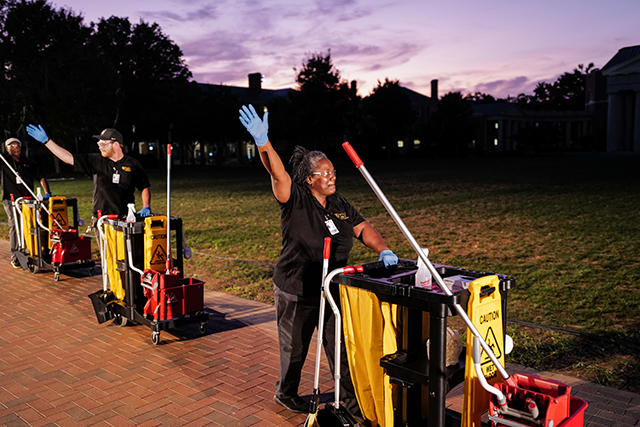
Custodians roll off the “stage” after their scene. From left, Bernard Clowers, London Thomas and Brenda Wall.
"This once-in-a-generation artistic happening exemplifies the intersection of arts and our wider campus that is a hallmark of our Wake The Arts initiative. As we seek compelling ways to engage all our students, faculty and staff in genuinely meaningful arts experiences, “From the Ground Up” will be remembered as a singular advance on that effort."
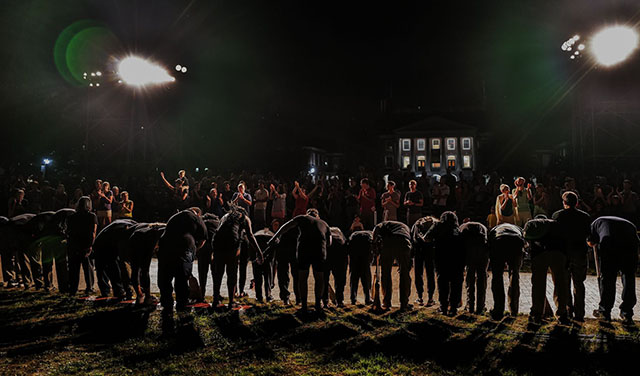
Performers take a bow together at the end of the show.
Behind the Scenes!
• Read our sidebar on students shadowing facilities workers
• See Ken Bennett’s photo gallery of rehearsals and shows at bit.ly/2p4Uzqa
• See a Wake Forest story and video at bit.ly/2VQWz17
• Watch a full recording of the show at bit.ly/2pG4YZk
• View the program guide here: “From the Ground Up”
MORE PHOTOS FROM THE SHOW
- Landscaper Damian Campbell rocks the Quad.
- Purple theatre lights bathe Wait Chapel’s columns.
- Custodian Doris Lopez was slow to warm up to the idea of performing, but by the third show, she was boogeying with her broom in the finale.
- From left, custodians Cynthia Wilson, Bernard Clowers, London Thomas and Brenda Wall show their juggling expertise during the performance.
- Composer Graham Reynolds of Austin, Texas, directs the gamelan performance.
- The landscaping team steps into the spotlight “From the Ground Up”
- Arborist Jim Mussetter removes toilet paper from the trees during one of the show’s most poignant moments as he wishes for a different celebration tradition to replace rolling the Quad.
- Fleet workers Mark Shouse, Bruce Avelar and Mark Beckerdite turn the art of changing tires on a golf cart into a comedy routine.
- The band includes saxophonist Ali Sakkal, associate teaching professor in the Department of Education.
- Carpenter Hugh Brown (P ’09) shows his skills in assembling dorm beds.
- President Hatch greets the cast and crew at a rehearsal.
- The crowd roars as the cast members line up for applause.


